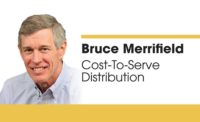The year 1994 was a vintage year for high-growth company analysis. David Birch concluded that 3% of the fastest-growing companies, known as gazelles, created most of the new jobs in the U.S.
Also, Bruce Kirchhoff concluded that 4% of firms formed in 1977-78 started growing and hiring rapidly six years after being founded. And, David Storey concluded that 4% of startups that survived 10 years were responsible for 50% of new jobs in the overall economy.
Researchers have gone on to try to correlate the gazelles with high innovation rates, and no one disputes the idea that firms with superior growth and profitability — compared to their peers — do so by differentiating themselves through innovation.
The great distributor divide
For the past 35 years, Al Bates (a regular presenter at Southern Wholesalers Association events and a consultant to the regional) has looked at financial survey stats for more than 10,000 distributors in more than 40 different channels. He ranked the entire pool of repeat survey subscribers by pre-tax return on total assets (ROTA) and uncovered a great chasm. The top 5% consistently averaged more than 20% ROTA over a 15-year period, while the bottom 90% survived at 7% ROTA. We can assume that as persistent, self-selected survey participants all these companies must be open to improvements. How then do the two groups differ in mindset?
Based on the research, my guess is the top 5% are perpetual learners and fearless experimenters. By contrast, the bottom 90% likely vow to try harder every year without deviating from general industry beliefs and best practices. Their generic, commodity practices yield commodity, herd-level results.
How to be better
My own research concludes that more than 30% of distributors have experimented with customer profitability analysis. Using analytics, these companies know they have a few big profitable accounts that pay for all of their losing accounts, hopefully with some residual operating profits.
Bates’ top 5% see past their initial superficial fears of confronting losing customers of all stripes. They muster the courage to invent new ways of serving both their best and their losing accounts.
They likely perform small-bet experiments that teach them how to win a bigger share of the best accounts, while turning losers into winners or, better yet, into their competitors’ losers.
The five I’s
Pay attention to the five I’s to gain your own momentum. Innovation needs analytical Information to identify the best target areas. Line-item profit analytics, for example, ranks customers by profitability then allows you to take deep dives to find the underlying, root causes for profits or losses. Understanding these causes gives you the insights for how to reduce hidden and unnecessary lose-lose activity costs for both you and customers.
But, employees won’t act on new plans from these insights until you first announce (future) changes for incentives. New incentives will not, however, train people to execute new tactics or remove their fears of initial failure and lost income. The initiative to act usually is missing, but you can find it by creating small initial wins to build self-fueling confidence.
There are other steps you can take to increase your innovation:
Allocate separate resources for the new stuff. You need a separate budget led by a fulltime champion, or the pressure to make monthly numbers will win.
Design low-risk, high-return experiments with guaranteed educational returns. (Google: “merrifield + think big, act small” and take a look at the PDF document, which is an annotated slide show).
Provide enough of a positive philosophy of “failing forward” (Google: “merrifield + slide 53”: “Improv Wisdom”).
Consider an outside company trainer to run weekly, one-hour, virtual meetings to keep everyone on task until snowballing wins emerge.
The same old remarks, such as “fail fast, forward and better” do not detail the actions that need to be taken the way the five I’s do. Embrace them.





